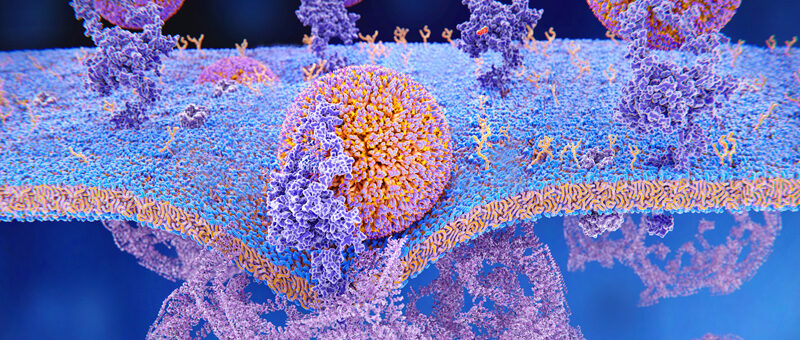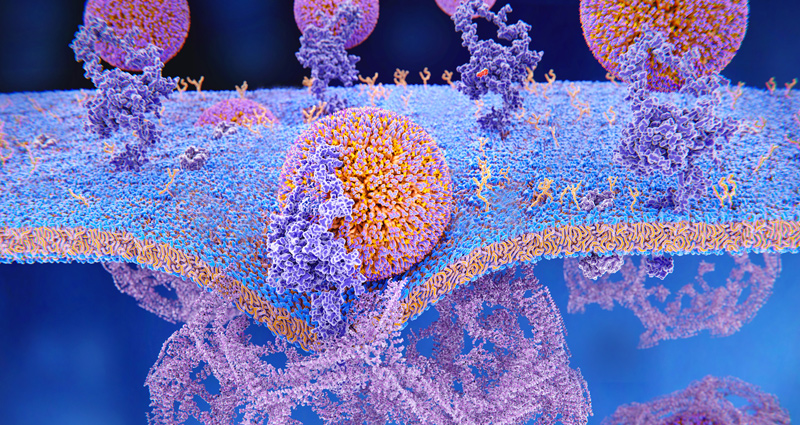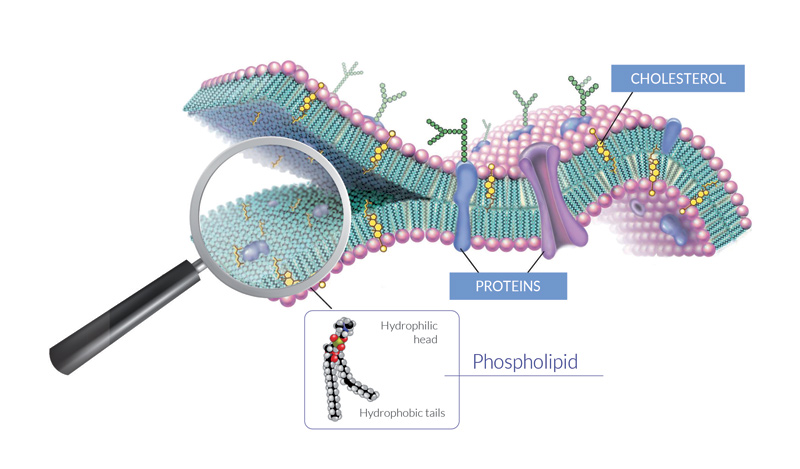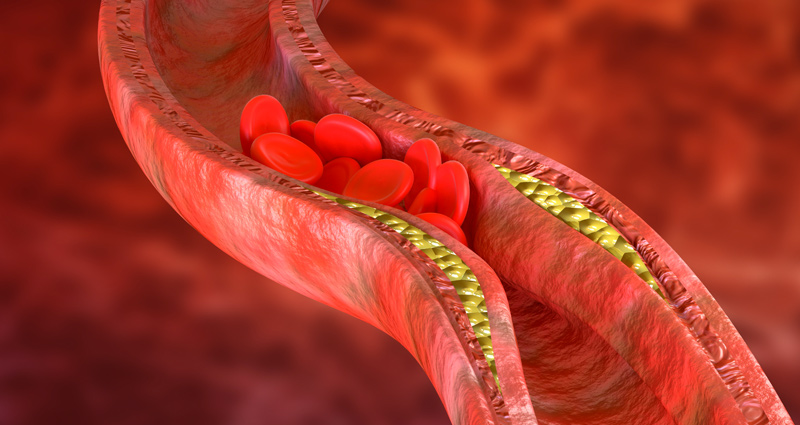
NEVER WITHOUT CHOLESTEROL

Cholesterol in membranes
Cholesterol is a molecule, belonging to the family of fats called sterols, with essential functions for life. It is in fact present in many tissues of the human body, and its properties are mainly carried out as a basic constituent of cell membranes.
Today, cholesterol is measured by the standard assessment performed by blood tests, that examine plasma cholesterol, or circulating cholesterol that binds to lipoproteins (HDL and LDL). A measurement that does not take into account the actual function of cholesterol, which is inserted into the phospholipid bilayer (cell membrane).
Full assessment of cholesterol also “inside” the membrane is needed, but is not yet available. Only when we have combined analyses will we reach an optimal understanding and a complete clinical picture especially when higher cholesterol levels are present.
The place of cholesterol, along with phospholipids
Cholesterol, placed in the phospholipid bilayer (cell membrane), is essential to create a distance between phospholipids that can give stabilization in both the fluid and gel phases. These two phases distinguish the cell membrane because it places channels and receptors that work either in the gel phase or the fluid phase. So the role of cholesterol is to “correct” in a very precisely way the consistency of the membrane, regulating fluidity and permeability, and working together with the quality of fatty acids so that the functions of transport, nutrient sorting, and signaling take place perfectly.

Cholesterol, being a lipophilic molecule, has the ability to interface with fatty acid chains and thus helps to regulate the organization, dynamics and oligomerization of key receptors, such as GPCR (G-protein coupled receptor). Numerous studies also show that the presence of cholesterol in the membrane, makes it more resistant to attack by external agents, such as light or chemical degradation [1].
Significantly, an increase in cholesterol is associated with the proliferation of cancer cells, paradoxically demonstrating the importance of this component when millions of cells are to be formed [2].
Cholesterol content in the membrane
By studying the composition of the membranes of various human tissues, it has been seen that the concentration of cholesterol varies consistently:
– Less than 10% cholesterol is found in the inner organelles of the cell, such as: endoplasmic reticulum, Golgi apparatus, and mitochondrial membranes;
– 10% to 30% cholesterol is the average contained in various tissues;
– Whereas more than 50% cholesterol is present in the membrane of: mature red blood cell, Schwann cells (myelin sheath), cells of the visual system.
Tissues give a signal, called “feedback,” about their membrane fluidity/rigidity, which is reflected in the production or not of cholesterol [3,4].

The correlation of the fatty acid composition of the mature red blood cell to the resulting cholesterol level in the individual has also been noted. In particular, the increase in cholesterol, depending also on the phenotype of the patients, occurs both in the case of excess saturated fat [5,6], and in the case of excess polyunsaturated fat (omega-6 as in inflammation and omega-3 in the case of excessive intake of these fats) with increase in both HDL and LDL [7]. Effect of lowering the total level of free cholesterol and triglycerides in plasma is also present [8] but is also much discussed. As mentioned earlier, one should have a complete assessment of cholesterol displacement in and out of the membrane to better understand the whole scenario.
The mature red blood cell can give us important information about these fatty acids to explain the reason for the membrane arrangement that is reflected in the level of cholesterol produced by the body. for the control of cholesterol in the membrane.
Lipidomics is one of the most important tools for rationalizing excess cholesterol and also making it visible to the individual i.e., explaining to him or her what dietary habits may be influencing the elevation.
Cholesterol metabolism and importance of diet
In cholesterol control, diet and lifestyle play a key role. In particular, one must recognize all daily behaviours that can adversely affect its internal regulatory mechanisms: intestinal absorption, hepatic synthesis, and biliary excretion.
A focus on daily habits must take into account that at the intestinal level, cholesterol production serves to create the first lipid particles (chylomicrons), so it performs a physiological function. In the presence of hypercholesterolemia, a portion of cholesterol to be reduced may be precisely at the intestinal level (through the sequestering action of beta glucans and plant sterols). The habit of consuming foods containing sterols or beta glucans needs to be established. Simultaneously, a good measure is the use of natural antioxidants, which serve to protect cholesterol from oxidation, since the real problem is oxidized cholesterol. Therefore, habits such as daily drinking green tea or natural pomegranate juice can be very helpful.
Beta glucans are contained in different types of foods such as oats (oat flakes and bran), barley, mushrooms.
Plant sterols (phytosterols) are found:
– In oils, such as extra virgin olive oil, soybean oil, rice oil, nut oil,
– in vegetables, such as broccoli, Brussels sprouts, cauliflower, green and black olives, lupins,
– in legumes
– in dried fruits: walnuts, hazelnuts, almonds.
Dietary allowances for beta glucans or phytosterols are 3g/day (EFSA)
Bibliography
[1] PNAS March27, 2018, 115(13), 3255-3260
[2] Cancer. 1994, 73(2), 253-8.
[3] Cell Biochem Biophys. 2017, 75(3-4),369-385
[4] inVivo 2021, 35(6), 2991-3000
[5] Arteriosclerosis, Thrombosis, and Vascular Biology. 2021, 41, 2823–2836
[6] PLoS One. 2017, 12(2), e0170664
[7] Exp Clin Cardiol. 2003, 8(4), 164-72.
[8] Curr Pharm Des. 2009, 15(36), 4087-93.
Article by the Editorial Group of Lipinutragen
The food recommendations in the article are not intended as a substitute for a personalized food plan and are to be adapted to specific cases.
Photo: 123RF Archivio Fotografico: 99488299 : ©juangaertner | 136133753 : ©agphotography
- On 3 March 2023



